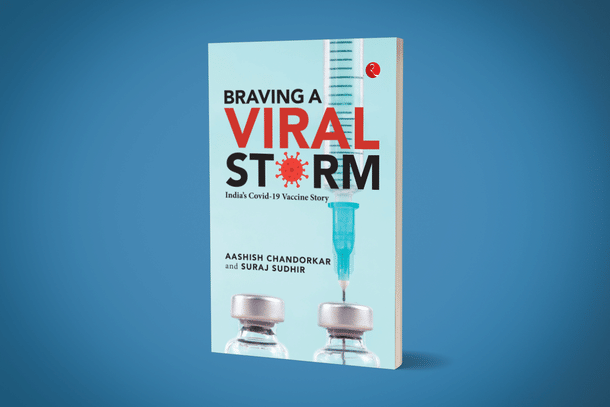Books
How India Aced The Covid Challenge
R Jagannathan
Jan 27, 2023, 01:10 PM | Updated 01:16 PM IST
Save & read from anywhere!
Bookmark stories for easy access on any device or the Swarajya app.


Braving A Viral Storm: India’s Covid-19 Vaccine Story. Aashish Chandorkar & Suraj Sudhir. Rupa. 2023. Pages 329. Rs 495.
Some time in the near future, India’s Covid-19 strategy will become a global case study on how a country of 1.4 billion people managed to overcome a deadly virus.
This was largely through its own efforts, thanks to great leadership and citizen involvement, well planned and even better executed public-private partnerships, use of digital technology, and in spite of withering and (largely) unfounded criticism of its actions in the global and domestic media.
But if you are unwilling to wait for that PhD thesis, you could do no worse than to read Aashish Chandorkar and Suraj Sudhir’s well-researched book, Braving A Viral Storm: India’s Covid-19 Vaccine Story.
Spread over 18 chapters, the book gives you a blow-by-blow account of how India perceived its challenges, and how it reacted to them, from the start of the pandemic in the dying months of 2019 to the current point.
India has administered over 2.2 billion doses of vaccines to its citizens so far, and the latter have developed 'hybrid' immunity from a combination of vaccine protection and natural immunity gained by actually contracting the disease.
In global comparisons, there is no country of the scale and size of India with a better vaccination spread. And the proof of the pudding lies in acknowledging where India stands today versus where China does.
In any normal race, autocratic China with huge state capacity would have been expected to fare far better than India, but China is still grappling with the disastrous side effects of its zero-IQ, zero-Covid strategy, while democratic India has stolen a march not only over China, but most parts of the world.
Chadorkar’s and Sudhir’s book tells us, in great detail, how India actually did it, and at least four clear heroes (among many others) emerge from their story: Prime Minister Narendra Modi, the Indian medical and scientific establishment, and the two main producers of the most used vaccines in India, Adar Poonawala of Serum Institute, who had the foresight to produce millions of doses at his own cost and risk so that we hit the ground running in January 2021, and Dr Krishna Ella of Bharat Biotech.
Between them they produced millions of doses every month, the former with Covishield, and the latter Covaxin, ensuring that India was more or less fully protected by mid-2022.
The book alternates between three types of narrative: setting the stage for the arrival of the global pandemic by the first quarter of 2021, giving historical background on vaccine development and India’s own role in it; and the intense discussions and whole-of-government approach to dealing with the pandemic that enabled an effective response.
The book contrasts India’s measured responses against the ones adopted in other countries, especially the US, which splashed billions of dollars on the vaccines and obtained a far lower bang for the buck than India.
Clearly, the blame for the spread of the virus must be laid at China’s door, which knew about it as early as in November 2019, but it was only by end-December and early-January that the Chinese authorities and the World Health Organization started acknowledging what the world was going to face in the coming weeks and months.
India reported its first Covid-19 case on 30 January 2020, and its first death by 12 March.
It redounds to the credit of the Indian government that between January and March-end, it had got large parts of its response ready, though there was going to be much to learn in the months ahead, and especially in 2021, when the Delta wave spiked unexpectedly, causing immense havoc and loss of life.
Even as the world was salivating at the prospect of India failing once again in the area of public health, the Modi government went into top gear to figure out how vaccines could be mass manufactured and delivered to the farthest places in the shortest possible time. What is particularly noteworthy is the fact that India did so at minimal cost and wastage.
The authors note: “The data is clear - till mid-2022, India administered more vaccines than either North America or Europe, using about 1.6 billion doses of Covishield and 340 million doses of Covaxin. With approximately the same number of total orders as North America, India administered twice as many doses. The data shows that ordering massive quantities of vaccines ahead of time did not guarantee their administration.”
What India did was order smaller quantities in line with expected near-term usage, and a lot of this was estimated using technology, including the CoWIN app that allowed citizens to register for vaccines and take them at no cost.
Chapter 9, which documents the learning curve in the vaccine rollout from January 2021, is very useful to understand how a government can improve decision-making using feedback loops involving both political critiques and its own assessments to finetune policies.
The vaccination policy, which seemed initially slow to take off, underwent an overhaul once the Delta wave struck with ferocity by February-March 2021.
The initial rollout plan involved vaccinating frontline workers, then extending it to vulnerable sections (the old and the unwell), and then to the entire adult population in stages.
But by March-April 2021, accelerating graphs of the Delta wave led to political demands for vaccinating all those above 18.
The initial slow pace led to uninformed criticism that it would take as much as a decade to vaccinate the entire population, and that if only more vaccines had been procured, the Delta wave could have been prevented from causing so much damage.
But Chandorkar and Sudhir show that even in the US, with one-fourth of India’s population and with a month’s head start on vaccinations, only 108 million doses had been administered by March 2021.
It had not covered its entire population even after three-and-a-half months.
Expecting India to have universalised immunities was a much more mammoth task in that kind of time frame. The critics were talking through their hats.
But two good things emerged along this learning curve: India gave out more orders of vaccines, and shifted from a policy of giving states freedom to buy their own vaccines to a centralised system that not only kept vaccine prices at manageable levels, but speeded up the rollout.
Today, it would be churlish to deny that India’s Covid strategy was a winner, despite the fact that mistakes and miscalculations were made in the initial stages of the vaccine rollout.
But the real takeout is the role a committed and agile government can play in quickly correcting the mistakes and ensuring that the population was protected.
The government and the medical fraternity did well despite a concerted campaign to cast doubts on one of the vaccines, Bharat Biotech’s Covaxin, and presumptions that the much more costlier Pfizer and Moderna vaccines were real options for India.
We know now that India stood on its own legs, and resisted pressures from global pharma interests to do what needed to be done in the most efficient and cost-effective manner.
The book has a 'foreword' by Health Minister Mansukh Mandaviya, and an 'afterword' by Adar Poonawalla, both well worth a read.
The authors have done a great job in writing current history with the depth that only hindsight can provide.
Jagannathan is former Editorial Director, Swarajya. He tweets at @TheJaggi.





